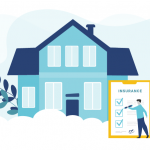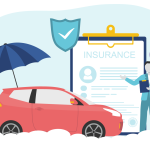12 Easy Ways to Save on Auto Insurance
September 1, 2020
It feels like Auto Insurance premiums are always on the rise. But even if you’re a perfect client with a clean claims history and zero accidents on record, there are still plenty of factors outside of your control that can hike up your rates.
Here are 12 practical ways to trim your Auto Insurance costs and put some extra cash back in your own pocket!

1. Drive responsibly.
This might seem like a no-brainer, but a clean driving record is the best way to keep your Auto Insurance down.
Insurance companies use your driving history to predict your driving future and determine your premium—and drivers with lots of accidents, traffic violations, or claims are considered high risk. A small, one-time incident won’t make a huge difference to your record, but multiple at-fault collisions, even if they’re minor, or a serious conviction will send your rates through the roof. And keep in mind, driving infractions stay on file for at least three years (6 years or more for accidents), so you’ll be paying a higher premium for a while.
PRO Tip:
Build good driving habits to minimize the chances of a collision and improve your road history. You know the drill: obey traffic laws, drive carefully, and keep your eyes on the road—and your rates low. If you do get a speeding or distracted driving ticket and feel you’re not at-fault, be sure to dispute the ticket through the court system and let your insurer know once it’s removed from your record.
2. Drive less.
Did you know that your car’s annual mileage affects your insurance? That’s right; if you only use your vehicle for short distances, your premium will be much cheaper than someone who spends three hours commuting to work every day. Why? The more you use your car, the greater your collision risk, especially if you’re travelling during rush hour when there are more vehicles on the road.
If you drive fewer than the average number of kilometres per year, you might be eligible for a low mileage discount. Plus, driving less means less wear and tear on your vehicle. And that means less on gas, parking, and car maintenance.
PRO Tip:
With more people working from home, driving less has become the norm. If you’re no longer driving to work and using your car on an as-needed basis (i.e to the doctor or grocery store), you could see savings of up to 15% by changing your vehicle’s purpose from “commuting” to “leisure.”
If you live in a two-vehicle household, consider taking one off the road and suspending coverage if you or your family members aren’t driving daily. But remember, you won’t be able to drive a vehicle with suspended coverage under any circumstances.
In general, it’s a good idea to try and reduce your mileage wherever you can and potentially lower your premium through carpooling, taking public transit, riding a bike to work, or even continuing to work remotely. But don’t forget to keep your broker updated on your driving habits.
3. Drive safe.
While most cars today come with a factory installed alarm system, your insurance company might reward you for going the extra mile to protect your car. Whether it’s a steering wheel lock, a GPS tracker, or an auto immobilizer, security devices won’t just help you prevent theft, they’ll also get you an insurance discount since your vehicle is less likely to be stolen. All you have to do is provide proof of installation.
We know it seems counterintuitive to drop a few hundred dollars on security add-ons in the hopes of a reduction or rebate–but sometimes you have to spend money to save money. And it’s never a bad idea to make your car a little safer.
PRO Tip:
Not all anti-theft devices qualify for discounts. Double check with your broker before installing anything in your vehicle to see if the initial cost is worth the savings.
4. Use winter tires.
Speaking of safety, if you haven’t already, consider investing in winter tires once the weather drops below 7°C. Winter tires provide better traction and control through snowy and icy driving conditions. They’re not mandatory across the country—laws vary between provinces—but they are crucial to fend off against the harsh Canadian winter. And they’ll get you an easy 5% off your auto rate from most insurers.
PRO Tip:
If you’re planning on changing your tires, hold onto your receipt and tire information and let your provider know once you’ve made the switch.
5. Be prepared for accidents.
No matter how cautious you are, accidents happen. And according to Aviva Canada, only 50% of Canadians are prepared to go through the claims process following a crash.
If you do get into an accident, make sure you’re well-versed on what to do afterwards. Following proper accident aftermath protocol will keep you (and anyone else involved) out of harm’s way, speed up claims handling, and potentially avoid a spike in your insurance if you report on time and with enough information.
PRO Tip:
In the event of a collision, try to stay calm. Notify your insurer (and the police if necessary). Record important details (time, date, photos, and the other driver’s information) and follow-up with your broker. For a detailed breakdown of what to do after a car accident, click here.
6. Pick the right car.
Regardless of your driving skills, some cars simply cost more to insure. That’s because Auto Insurance premiums are based on the previous claims history for the vehicle. The more likely a car is to break down or be stolen, the more you’ll pay. That means the age, make, model, safety rating, price, and even the colour of your vehicle can drive your auto rate higher.
Expensive luxury vehicles, rare sports editions, and newer cars are some of the biggest culprits, especially if they require replacement parts that are difficult to source. In contrast, insurance-friendly vehicles, like minivans, four-door sedans, and mid-tier SUVs, are typically safe, reliable, and reasonably priced, with a lower theft score and strong security features.
PRO Tip:
Before you pick your next ride, factor auto rates into your decision making process. Compare insurance quotes to see how your new car measures up. Some insurers might even discount you for buying a hybrid or electric car.
7. Bundle up.
One of the easiest ways to save? Buying two policies from the same carrier. Bundling Home & Auto Insurance won’t just simplify your finances, it’ll save them with anywhere from 5-25% off your monthly premiums.
Plus, the more valuable your home, the larger your bundling discount (unless you live in a high-risk area). That means adding your house to your policy can offset the hefty premium of an expensive car with heavy repair costs, a long claims history, or record of major collisions.
PRO Tip:
If you currently have two policies through separate companies, look into a Home & Auto bundle around renewal time from a single provider to maximize your savings.
8. Adjust your deductible.
A deductible is the amount of money you pay out-of-pocket towards a claim before your insurance policy kicks in. Generally speaking, the lower your deductible, the higher your premium. If you increase your deductible, your premium will drop, in some cases by as much as 25%.
Here’s why: a higher deductible reduces your insurance company’s financial obligations because you’re agreeing to take on a larger portion of the cost if there’s a claim. Say you got into a minor accident that cost $1,500. With a $250 deductible, you’d have to pay the first $250 of the repair costs; your Auto Insurance would handle the remaining $1,250. But if you had a $1,000 deductible, your insurance company would only need to shell out $500.
PRO Tip:
If you’re confident in your ability to avoid a collision, raising your deductible will save you money. The repair bills from most minor accidents are usually within the range of a larger deductible anyway, so you’d already be out the cost.
However, you shouldn’t set your deductible so high that you’ll have trouble paying if needed. As a general rule of thumb, you should have enough cash set aside to cover the full amount of your deductible at any given time. Be sure to run any changes by your broker first though.
9. Work on your credit score.
A solid credit score can do wonders for your auto rates. Many insurers use credit information to price their policies and research shows that people with lots of credit issues are much more prone to risky behaviour, like missing or delaying payments and filing more claims.
PRO Tip:
Build, or maintain, your credit over time by paying your bills right away, keeping your balances under 50% of your limit, and opening new credit accounts only when necessary. Try to resolve any delinquent accounts before requesting an auto quote and monitor your statements regularly so the information is accurate. The better your score, the cheaper your insurance.
10. Review your coverage.
Your premium is based on the information you provide when you apply. Most policies auto-renew annually, but a lot can happen in a year. Maybe you now work closer to home or your children have moved out. Or maybe they’ve moved back in and you need to add a driver to your policy. Whatever the reason, it might be time to make some changes.
Get into the habit of thoroughly reviewing your policy around renewal time every year. Renewal is the perfect opportunity for you to increase or decrease your limits, seek new discounts, and adjust your policy to reflect your current needs. Reading your insurance policy can be time-consuming, but in most cases you’ll see a difference to your bottom line right away.
PRO Tip:
Make sure the details about your driving history, vehicle, and personal information are up-to-date. Even a small error could cost you money or worse, nullify your coverage when you file a claim. And keep your provider posted about any major changes (i.e. different drivers, vehicle usage or mileage etc.).
11. Don’t miss payments.
Pay your premium on time, every time. Depending on your provider, missing even one payment could be grounds for cancellation. If your policy is cancelled, you’ll have trouble securing Auto Insurance in the future; with multiple cancellations, it’ll be near impossible. And if you do manage to find coverage, it’ll be significantly more expensive.
PRO Tip:
Try to set up automatic payments. Ensure there’s always enough in your account to avoid nonpayment and any associated penalties or interest fees. If you think you might be late or miss your payment, be proactive and give your insurers notice well in advance.
12. Compare, compare, compare.
Don’t make the costly mistake of assuming all companies charge the same price for the same benefits. Rates vary between carriers, so it pays to shop around.
And sometimes the cheapest price isn’t always the best price. In addition to the cost, consider what you’ll get for your money: the coverage, the claims service, and the losses covered. Sure, it’ll take a bit of extra time, but a little research goes a long way when it comes to your Auto Insurance.
Or have a broker—like PROLINK—do it for you. After all, that’s what we’re here for. We’ll offer personalized advice and help you compare quotes to make sure you’re getting the best bang for your buck. With over 40 years of industry experience, PROLINK has the expertise to guide you to the right coverage from the right insurer at the right price.
To learn more, connect with PROLINK today!
PROLINK’s blog posts are general in nature. They do not take into account your personal objectives or financial situation and are not a substitute for professional advice. The specific terms of your policy will always apply. We bear no responsibility for the accuracy, legality, or timeliness of any external content.




